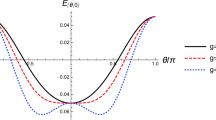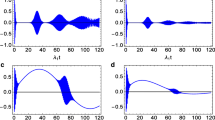Abstract
The Rabi model describes the simplest interaction between a two-level system and a bosonic mode beyond the rotating wave approximation. The antiresonant terms that result from this coherent interaction play an important role. In this paper, we go beyond the rotating wave approximation even for the interaction with vacuum. This leads to the ’incoherent’ antiresonant terms. Using the master equation which includes both coherent and incoherent antiresonant terms, we numerically compute the mean photon number and show that these incoherent antiresonant terms enhance the generation of mean photon number. Moreover we study numerically the effect of the detuning and show that it also enhances the generation of photons. Finally, we generalize our result to two two-level and two-mode systems.






Similar content being viewed by others
References
Edwin T. Jaynes, Frederick W. Cummings, Comparison of quantum and semiclassical radiation theories with application to the beam maser. Proc. IEEE 5(1), 89–109 (1963)
Gerhard Rempe, Herbert Walther, Norbert Klein, Observation of quantum collapse and revival in a one-atom maser. Phys. Rev. Lett. 58, 353–356 (1987)
M. Weidinger, B.T.H. Varcoe, R. Heerlein, H. Walther, Trapping states in the micromaser. Phys. Rev. Lett. 82(19), 3795 (1999)
Alexandre Blais, Jay Gambetta, Andreas Wallraff, David I. Schuster, Steven M. Girvin, Michel H. Devoret, Robert J. Schoelkopf, Quantum-information processing with circuit quantum electrodynamics. Phys. Rev. A 75(3), 032329 (2007)
Alexandre Blais, Ren-Shou. Huang, Andreas Wallraff, Steven M. Girvin, R. Jun Schoelkopf, Cavity quantum electrodynamics for superconducting electrical circuits: an architecture for quantum computation. Phys. Rev. A 69(6), 062320 (2004)
I. Chiorescu, P. Bertet, K. Semba, Y. Nakamura, C.J.P.M. Harmans, J.E. Mooij, Coherent dynamics of a flux qubit coupled to a harmonic oscillator. Nature 431(7005), 159–162 (2004)
Andreas Wallraff, David I. Schuster, Alexandre Blais, Luigi Frunzio, R.-S. Huang, Johannes Majer, Sameer Kumar, Steven M. Girvin, Robert J. Schoelkopf, Strong coupling of a single photon to a superconducting qubit using circuit quantum electrodynamics. Nature 431(7005), 162–167 (2004)
J. Johansson, S. Saito, T. Meno, H. Nakano, M. Ueda, K. Semba, Hideaki Takayanagi, Vacuum rabi oscillations in a macroscopic superconducting qubit l c oscillator system. Phys. Rev. Lett. 96(12), 127006 (2006)
Daniel Braak, Integrability of the rabi model. Phys. Rev. Lett. 107(10), 100401 (2011)
I.I. Rabi, Space quantization in a gyrating magnetic field. Phys. Rev. 51(8), 652 (1937)
RobertH. Dicke, Coherence in spontaneous radiation processes. Phys. Rev. 93(1), 99 (1954)
J.J. Hopfield, Theory of the contribution of excitons to the complex dielectric constant of crystals. Phys. Rev. 112(5), 1555 (1958)
Michael Tavis, Frederick W. Cummings, Exact solution for an n-molecule-radiation-field hamiltonian. Phys. Rev. 170(2), 379 (1968)
Anton Frisk Kockum, Adam Miranowicz, Simone De Liberato, Salvatore Savasta, Franco Nori, Ultrastrong coupling between light and matter. Nat. Rev. Phys. 1(1), 19–40 (2019)
Keiji Saito, Martijn Wubs, Sigmund Kohler, Yosuke Kayanuma, Peter Hänggi, Dissipative landau-zener transitions of a qubit: Bath-specific and universal behavior. Phys. Rev. B 75(21), 214308 (2007)
Martijn Wubs, Sigmund Kohler, Peter Hänggi, Entanglement creation in circuit qed via landau-zener sweeps. Phys. E: Low-dimensional Syst. Nanostruct. 40(1), 187–197 (2007)
Clive Emary, Tobias Brandes, Chaos and the quantum phase transition in the dicke model. Phys. Rev. E 67(6), 066203 (2003)
David Zueco, Georg M. Reuther, Sigmund Kohler, Peter Hänggi, Qubit-oscillator dynamics in the dispersive regime: analytical theory beyond the rotating-wave approximation. Phys. Rev. A 80(3), 033846 (2009)
A. Lupaşcu, E.F.C. Driessen, L. Roschier, C.J.P.M. Harmans, J.E. Mooij, High-contrast dispersive readout of a superconducting flux qubit using a nonlinear resonator. Phys. Rev. Lett. 96(12), 127003 (2006)
L. Garziano, R. Stassi, V. Macrì, A.F. Kockum, S. Savasta, F. Nori, Multiphoton quantum rabi oscillations in ultrastrong cavity qed. Phys. Rev. A 92(6), 063830 (2015)
T. Niemczyk et al., Circuit quantum electrodynamics in the ultrastrong-coupling regime. Nat. Phys. 6, 772 (2010)
Sahel Ashhab, Franco Nori, Qubit-oscillator systems in the ultrastrong-coupling regime and their potential for preparing nonclassical states. Phys. Rev. A 81(4), 042311 (2010)
Andrew P. Hines, Christopher M. Dawson, Ross H. McKenzie, G.J. Milburn, Entanglement and bifurcations in jahn-teller models. Phys. Rev. 70(2), 022303 (2004)
P. Forn-Díaz, L. Lamata, E. Rico, J. Kono, E. Solano, Ultrastrong coupling regimes of light-matter interaction. Rev. Mod. Phys. 91(2), 025005 (2019)
Luigi Garziano, Vincenzo Macrì, Roberto Stassi, Omar Di. Stefano, Franco Nori, Salvatore Savasta, One photon can simultaneously excite two or more atoms. Phys. Rev. Lett. 117(4), 043601 (2016)
Xin Wang, Adam Miranowicz, Hong-Rong. Li, Franco Nori, Observing pure effects of counter-rotating terms without ultrastrong coupling: a single photon can simultaneously excite two qubits. Phys. Rev. A 96(6), 063820 (2017)
T. Werlang, A.V. Dodonov, E.I. Duzzioni, C.J. Villas-Bôas, Rabi model beyond the rotating-wave approximation: generation of photons from vacuum through decoherence. Phys. Rev. A 78(5), 053805 (2008)
C.S. Munoz, A.F. Kockum, A. Miranowicz, F. Nori. Ultrastrong-coupling effects induced by a single classical drive in jaynes-cummings-type systems. arXiv preprint arXiv:1910.12875, (2019)
Ye-Hong. Chen, Wei Qin, Xin Wang, Adam Miranowicz, Franco Nori, Shortcuts to adiabaticity for the quantum rabi model: efficient generation of giant entangled cat states via parametric amplification. Phys. Rev. Lett. 126(2), 023602 (2021)
C. Gardiner, P. Zoller, Quantum Noise: A Handbook of Markovian and Non-Markovian Quantum Stochastic Methods with Applications to Quantum Optics Springer Series in Synergetics. (Springer, Berlin, 2004)
Acknowledgements
This research is supported in part by Malaysia Higher Education Ministry Research Grant FRGS 17-024-0590. AM would like to thank Prof Ficek Zbigniew for fruitful discussion.
Author information
Authors and Affiliations
Corresponding author
Appendix A. Equation of motion using modified input-output theory
Appendix A. Equation of motion using modified input-output theory
The antiresonant terms that result from the interaction of a system with vacuum are usually ignored in the derivation of master equation [30]. In this Appendix we show how to generalize this master equation by taking into account these antiresonant terms in the quantum Ito stochastic differential equation.
Our model consists of a system interacting with a bath. The Hamiltonian of the system-bath is typically written as the sum of three Hamiltonians
where \(H_{sys}\) is the Hamiltonian of the system which will specify it later. The Hamiltonian of the bath is given by
while, \(H_{int}\) is the interaction Hamiltonian consisting of the sum of two Hamiltonians, the Hamiltonian \(H_{int}^{res}\) which corresponds to the resonant terms and \(H_{int}^{anti}\) corresponds to the anti-resonant terms
where
In the standard input-output theory [30], the Hamiltonian \(H_{int}^{anti}\) is completely ignored. This is the well know the RWA, which is valid if the coupling strength is weak. Here we go beyond the RWA and keep all the antiresonant terms in the Hamiltonian \(H_{int}^{anti}\). The equations of motion for a and b are given by
where a is an arbitrary system operator. The solution of Eq. (A.6) is
The last term in Eq. (A.8) is due to the anti-resonant term. So, in weak interaction regime, one can ignore this term and write
This is our first approximation. Substituting the solution for b, Eq. (A.9), into the equation of motion for a, Eq. (A.7), we obtain
Now we use the Markov approximation. This is our second approximation. In this approximation we assume that the bandwidth of the bath is large enough so that the coupling constant \(\kappa (\omega )=\sqrt{\varGamma /\pi }\). So, the Langevin equation can be simplified and takes the form
where \(\varDelta \) is a result of the integral of the Cauchy principal value. We also note here that the computation of the integrals involving the counter rotating terms should be done with care. In principle, the parameter \(\kappa ^2(\omega )\) is proportional to the frequency \(\omega \), and these terms are resonant only in the negative frequencies. So, we need to transform these integrals to the negative frequencies first. This is why the negative sign appears before \(\varGamma /2\) in Eq. (A.11), that is,
Transforming the Langevin equation (A.11) to the quantum stochastic differential equation, we get
where we use the notation \(dB_{in} = b_{in} dt\). Let us focus now on the ordinary vacuum as an input. In this case, the noise operators that depend on dB and \(dB^\dagger \) are ignored. Thus, the Ito quantum stochastic differential equation is then given by the same equation (A.12). From this equation one can find the master equation. It takes the form
The last two terms of the equation above are due to the incoherent antiresonant terms.
Rights and permissions
About this article
Cite this article
Wahiddin, M.R., Belkada, R., Mahmoud, G.S. et al. Enhancing photon generation in cavity through antiresonant terms of the vacuum Rabi coupling. Eur. Phys. J. Plus 136, 650 (2021). https://doi.org/10.1140/epjp/s13360-021-01643-1
Received:
Accepted:
Published:
DOI: https://doi.org/10.1140/epjp/s13360-021-01643-1




